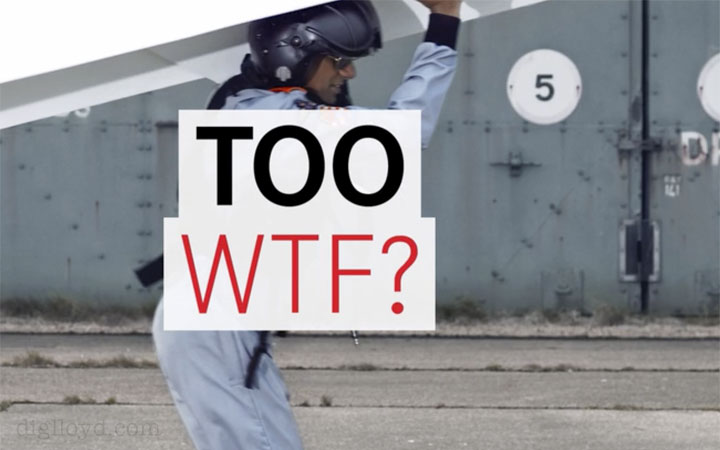Leica SL Typ 601 Full-Frame Mirrorless Camera System: the Logical Joining of DSLR and Mirrorless
See my Leica SL wish list at B&H Photo.

Today, Leica announced the Leica SL 24-megapixel mirrorless camera system. With a snazzy (boring) video visibly blurred on my 4K and/or Retina displays.
Interesting to see WTF* used in a marketing video by a mainstream company. I guess profanity is now hip enough? But I like apropos double entendre.
The Leica SL is the logical evolution forward from the DSLR, dispensing with the dead weight of an optical viewfinder (unusable for critical focus**) but otherwise merging some of the best of DSLR and mirrorless systems. So I applaud Leica for being the first company to take the logical step of building a mirrorless DSLR replacement. Which tradition-bound Canon and Nikon ought to have done two years ago.
While Sony has focused on making mirrorless full frame small, there exists no rule that says mirrorless must be so. Already, the Sony A7R II is too small and its ergonomics suffer for it, namely the buttons and 4-way controller. By dint of its larger form factor, the Leica SL has (had) the opportunity for excellent DSLR ergonomics. But from the look of the Leica SL camera rear, the SL shares too many genes with the Leica S. Since the S was for me was an operational time-wasting headache in the field, the rear of the Leica SL does not hold out much hope—minimalism for the sake of appearance, resulting in myriad operational time-wasting chimping exercises. Those flat buttons around the LCD screen are awful (placement, response, feel, etc), but there they are on the SL! At least there is a small 4-way controller at camera rear. As much as I’ve griped about the Sony A7 series controls, from what I see of the SL I’ll take the Sony A7R II controls over the SL any day. But I’ll keep an open mind, pending an actual hands on. And I hear that the SL is quite responsive, so for some shooters just pressing the shutter button, that might be all that matters.
Apparently the 4.4MP EVF has no peer, and is spectacularly good compared to everything else. A super high res EVF is a no-brainer mandatory feature for a DSLR replacement; I’ve been asking for such an EVF for about two years now, but kudos to Leica for a “first” in this area.
* Generally stands for 'What the f*ck.
** A high quality optical viewfinder (OVF) is expensive and bulky and of course indispensable for some types of shooting (sports, etc). But for most purposes, it is just dead weight and it is impossible to achieve critical focus on Canon or Nikon with the awful focusing screens designed for autofocus.
Size and weight
Roughly speaking, the camera and lenses are like shooting a Nikon D810 with Zeiss Otus:
- Leica SL camera with battery: 846g / 1.856 lb, about $7450
- Leica Vario-Elmarit-SL 24-90mm f/2.8-4 ASPH: 1140 g / 2.5 lb , about $4950. The 24-90 offers OIS (optical image stabilization).
- Leica 50mm f/1.4 Summilux-SL ASPH (due “end of 2016”).
- Leica 90-280mm f/2.8-4 APO Vario-Elmarit-S (unclear when available).
= about $13000 and 4.4 pounds for a starter system with an extra battery or two.
What’s it for?
What’s it for?
I’m a bit baffled by the target market, other than video:
- Is it a replacement for the M240, at least in part?
- M lenses can be used with the M-Adapter L, but it’s unclear how they perform (sensor cover glass thickness and ray angle concerns). Leica R and Leica T and Leica cine lenses can also be used with an adapter.
- The 24MP resolution is a waste of time for serious landscape use when 36/42/50 megapixel options exist at far lower cost.
- The native lens line is currently one (1) monster-sized zoom (which I hear may have serious focus shift issues at the long end, the kiss of death for sharpness). In the pipeline are a 90-280mm f/2.8-4 and a 50mm f/1.4 Summilux-SL ASPH (“end of 2016” for the 50/1.4).
- It’s too bulky and obnoxious for street shooting with the 24-90.
- Where are optimized-for-mirrorless autofocus SL lenses similar in size to Zeiss Loxia lenses? That would have been interesting. Instead we get quite large and heavy lenses with the SL.
- Particularly given the cost of the Leica SL, one has to ask why the new S wasn’t given a makeover with the EVF. Now that would have made sense.
The target market... see the comment by Jorge T at end.
What’s missing
- In Body Image Stabilization (IBIS), as on Sony A7 series.
- Leaf shutter lenses. At this high end, I want leaf shutters for high speed flash sync.
- UPDATE: Leica confirms no EFC shutter (mechanical shutter only). UPDATE 2: an EFC shutter option will come in a firmware update.
Does it have an EFC shutter? The specifications indicate that it is a mechanical shutter (30 minutes to 1/8000). Though the specifications do not rule out some EFC mode, IMO the lack of an EFC shutter makes a camera DOA as far as I’m concerned. The M240 shutter damages image at 90mm on up due to its shutter vibration. It damaged every photo I took at 280mm at 1/125 and slower, with varying degrees of sharpness loss down to 90mm focals (with lens adapter). If the SL behaves similarly, look out. - Sensor resolution was state of the art 4-5 years ago. Should be 36+ megapixels.
- Articulating rear LCD.
- Native lens line will be years in coming, particularly prime lenses at critical focal lengths, with only one lens, the 50/1.4 Summilux-SL due out by “end of 2016” and no other prime lenses announced. The camera will likely be outclassed by Sony and maybe Nikon and Canon by the time the 50/1.4 arrives.
One might ponder the relative value proposition of a ~50 megapixel Nikon or Canon DSLR with EVF and Zeiss Otus lenses (28mm, 55mm, 85mm). For less than the cost of the Leica SL with 28-90, the Nikon D810 or Canon 5DS R with two Otus lenses can be had right now—though no EVF option there, and no 4K video. But what happens in 2016 with CaNikon?
Value
Value is not what you get now; it’s what the system delivers over its lifespan. A bit over two years ago I took a risk and bought the M240 and the 50/2 APO at a huge cost that I now deem foolish. I may borrow the new SL system for testing, but I can’t make these prices work for owning—$13K for a starter system has no ROI on owning it. Extras and other lenses will easily push this system to the $20K mark or higher.
Convergence
The Leica SL offers an interesting combination of true 4K video and a very wide ISO range.
Presumably the sensor quality is top notch given the modest 24 megapixel resolution, but 24MP is far lower than the Sony A7R II (42MP) and the Canon 5Ds R (50MP). As I’ve shown with many comparison over the past few years, a 36/42/50 megapixel image downsampled to 24MP has no competition on its relative freedom from digital artifacts (aliasing, moiré, etc) and the per-pixel detail, versus a native 24MP sensor.
While 24 megapixels is ample for many purposes, when I invest time and sweat in a hike lugging a camera and tripod, I really want the details. Heck, I want the details handheld, and I get that with the in body stabilization of the Sony A7R II. Speaking to details, the lichen on the Tetrahedron Boulder series the Canon 5DS R would go to mush at 24MP, since the details are not that far off sensor resolution. I’ll take the details: I like the goodies I find after the shot at 42MP or 50MP. While 24MP is just fine with reportage and grab shots and various stuff (plenty of things), there are also many shooting applications in which more detail is rewarding. And since the same effort has to go into making the image, I’m no fan of low-res.
Based on all the M9, M240 and S, 24MP without an anti-aliasing filter will have ugly moiré and aliasing under some circumstances. If the lenses are good, this means severe “Christmas tree” speckles on things like fine white aspen or birch tree branches. I’ll take 42MP or 50MP, which are much less prone to such digital flaws.
Value
Now here’s my gripe: Leica clearly has taken the “tech” forward. So why can’t my M240 not lock up every day I shoot it in the field, why is there no “My Menu” option after two years, and why is the toy-grade low-res EVF still the only option for the M240. How can I possibly justify flushing $13K into yet another Leica body when support for existing models is lackluster at best? Leica does not deliver value to the buying proposition, and that is proven by action (inaction).
Description
Key features highlighted in the product description below. Clearly video is a key feature in the SL, as its discussion comes early and amply in the description. It will be interesting to see whether the 24-90mm has “breathing” and/or is parfocal.
Not mentioned is whether it has an electronic first curtain shutter (EFC shutter). This is a critical feature, so its omission is concerning.
Best-in-class may be an understatement for the Leica SL (Typ 601) Mirrorless Digital Camera, an outstanding full-frame model that is offering professionals the "new Leica experience." This generation of Leica is aimed to take the top spot of modern imaging technology and by the implementation of an outstanding 24MP CMOS sensor and Leica's Maestro II processor, it will deliver among the best in image quality with sensitivities ranging from ISO 50-50000. The sensor also forgoes the use of a low-pass filter in order to maximize possible detail, especially with the use of Leica's outstanding lens lineups. And, to make the camera a true professional's tool, Leica has incorporated internal DCI 4K (4096 x 2160) video recording at 24 fps, along with the L-Log gamma for maximum dynamic range.
Beginning with stills, the sensor and processor combination delivers high-resolution images at a rate of up to 11 fps. The 2GB internal buffer also allows for bursts of up to 33 DNG files or unlimited JPEGs. The Contrast AF system is claimed to be the fastest among full-frame cameras with 49 fields to work with. This ensures that photographers will not miss the decisive moment.
Video is outstanding, with UHD 4K (3840 x 2160) at 30 and 25 fps available in addition to DCI 4K. Alongside this impressive resolution is the ability to utilize the L-Log gamma, a super flat profile that maximizes the dynamic range of the image and gives editors more information to work with in post production. Video is easily recorded internally via the UHS-II and UHS-I standard SD card slots at 4:2:0 8-bit sampling rate though it can be output over HDMI with 4:2:2 10-bit sampling. Super35 and full-frame options are also available, depending on your resolution and frame rate.
Also available is Full HD (1920 x 1080) and standard HD (1280 x 720) at up to an impressive 120 fps for slow motion. Numerous other video recording features were implemented on the SL (Typ 601) to make high-quality recording easier, this includes focus peaking, exposure simulation, clipping/zebras, grid overlays, aspect ratios, and safe area. Audio is also supported with a built-in stereo microphone and both a 3.5mm headphone jack and 3.5mm microphone input. Manual and auto audio control is available.
Made in Germany from two blocks of solid aluminum, the SL (Typ 601) fits right in with Leica's other precision made imaging tools. This body is designed for intuitive use, with numerous dials and buttons in addition to the implementation of a rear 2.95" 1.04M-dot rear LED touchscreen for hybrid operation as part of Leica's Professional user interface. The body also offers a spacious 0.66" EyeRes 4.4MP EVF with a fast refresh rate of 60 fps and a magnification of 0.8x for more natural handling and composition.
The weather-resistant body has a variety of other features packed into it with dual SD card slots, one with the UHS-II standard and a backup with the UHS-I standard, as well as a 1.3" top monochrome LCD screen for quickly viewing and changing exposure settings. Along with all of this, the SL (Typ 601) has built-in Wi-Fi connectivity for remote control and image capture using the Leica SL App and a GPS unit for geo-tagging your photographs.
Leica SL (Typ 601)
Milled from two solid blocks of aluminum and packed with the latest and greatest in imaging technology, the Leica SL (Typ 601) is a full-frame mirrorless camera ushering in the new, professional Leica experience. The SL takes on all fronts with outstanding 24MP stills and high-quality DCI 4K video, along with a best-in-class 4.4MP EVF with a magnification of 0.8x. Optimized for speed as well as quality, it delivers one of the fastest AF systems available in a full-frame camera as well as a burst rate of 11 fps. With exceptional quality and fast operation, the SL (Typ 601) allows shooters to take on nearly any scene with ease, be it nature, sports, action, or press photography.
24MP Full-Frame CMOS Sensor & Leica Maestro II Processor
Packed with a phenomenal 24MP full-frame CMOS sensor that omits the low-pass filter and the Leica Maestro II processor, the SL (Typ 601) will deliver sharp, finely detailed images throughout the wide sensitivity range of ISO 50-50000.
This setup will also enable speed, with burst shooting up to 11 fps for up to 33 DNG frames, or unlimited JPEGs, thanks to a 2GB buffer. DCI 4K video is also supported at 24 fps along with Full HD at up to 120 fps for slow motion capture. Furthering the camera's performance is a fast Contrast AF system, which Leica claims is the fastest available in a full-frame camera, which uses 49 fields to lock on quickly and accurately. Ultrasonic dust cleaning further ensures image quality remains at its peak by removing small particles without the need for deep cleaning.
[diglloyd: Glad to see a true ISO 50, which presumably means very high pixel quality. But 24MP is low-res in 2015, and unacceptable too many of my purposes].
Leica L Bayonet Mount
First seen in the Leica T, the renamed L bayonet mount offers users the ability to connect full-frame SL-series glass which benefits from electronic communication for blazing fast autofocus, electronic aperture control, and optical image stabilization. The mount also works with existing and future TL-series lenses, though in a reduced resolution APS-C crop mode. Additionally, as with most mirrorless today, the L mount can accept a variety of adapters, such as the M-Adapter T which provides shooters with access to the entire M-mount lens library. Leica will have adapters for the S, R, and Cine series as well, ensuring compatibility with a range of Leica's best lenses.
DCI 4K Video Recording & L-Log gamma
High-quality video has become a highly important feature for numerous hybrid shooters and Leica has taken steps to deliver the best video available with the implementation of DCI 4K (4096 x 2160) video at 24 fps for true, cinema quality. Alongside this impressive resolution is the ability to utilize the L-Log gamma, a super flat profile that maximizes the dynamic range of the image and gives editors more information to work with in post production. L-Log gamma also allows for better color matching with existing systems and has similar characteristics to Cineon, which is used for film digitization.
This is easily recorded internally via the UHS-II and UHS-I standard SD card slots at 4:2:0 8-bit sampling rates. When output over HDMI however, this can be improved to 4:2:2 10-bit sampling, ensuring the maximum image quality possible with the full-frame sensor. Super35 and full-frame options are also available, depending on your resolution and frame rate.
The SL offers also UHD 4K (3840 x 2160) at 30 or 25 fps and Full HD (1920 x 1080) and standard HD (1280 x 720) at up to an impressive 120 fps for slow motion. Numerous other video recording features were implemented on the SL (Typ 601) to make high-quality recording easier, this includes focus peaking, exposure simulation, clipping/zebras, grid overlays, aspect ratios, and safe area. Audio is also supported with a built-in stereo microphone and both a 3.5mm headphone jack and 3.5mm microphone input. Manual and auto audio control is available.
[diglloyd: is this camera primarily for video? A lot of efforts here].
4.4MP EyeRes Electronic Viewfinder
Spacious and comfortable, the high-resolution 0.66" 4.4MP EyeRes EVF found on the SL (Typ 601) features a best-in-class magnification of 0.8x along with a field of view of 37°. This system also has a refresh rate of 60 fps, ensuring crystal clear and smooth imagery for the best shooting experience possible.
[diglloyd: Outstanding! Now offer this for M240, even if the frame rate is low].
2.95" 1.04M-Dot Rear LED Touchscreen
Hybrid operation as part of Leica's latest Professional user interface is enabled through the use of the 2.95" rear LED touchscreen. This display offers a high resolution of 1.04M-dot for crisp imagery during shooting. This screen also features a variety of different assist tools for capturing video and stills. In addition to this, the screen has anti-fingerprint and anti-scratch coatings along with a wide viewing angle of 170°.
[diglloyd: yawn. At this price I expect a iPhone style Retina display].
Contrast AF System
Claimed by Leica to be the fastest autofocus available in a full-frame camera, the SL (Typ 601)'s Contrast AF system uses static, dynamic, and automatic with face detection modes . This offers point, field, and zone options which can be broken down into 9 zones, 37 or 49 fields for excellent customization in locking down your target. Also, it has a Touch AF setting for tapping where you want to focus and an AF assist lamp will help in low-light conditions.
[diglloyd: but what area of the frame is covered, can it be used in zoomed Live View, etc. Some critical behaviors are not mentioned here].
Dual SD Card Slots
For security, Leica has incorporated two SD card slots into the SL (Typ 601), one with the fast UHS-II standard and one with the UHS-I standard. This ensures that professionals will be able to maintain a backup as they are shooting in case of card failure or loss. Also, it expands the capacity of the card during exceptionally long days of shooting or recording video.
Body Design & Menu
With a full, heavy-duty grip and a variety of buttons and dials, the SL (Typ 601) is designed to be one of the simplest, fastest, and most intuitive cameras to operate. The menu is optimized for speed and to be easy-to-understand, limiting time getting used to a new system and ensuring that you can find and adjust critical settings when you need to. Hybrid operation in the form of the latest Leica Professional interface is available thanks to the implementation of a rear touchscreen. This makes swiping through settings and images intuitive and enables Touch AF and shutter functionality. Additionally, the body has a top 1.3" monochrome LCD that shows current settings for making fast changes without looking at the rear screen or viewfinder.
Flash System
Equipped with both a TTL-capable hot shoe and an X-sync terminal, users will be able to easily add light to their scene. The hot shoe features dedicated contacts for TTL automatic exposure with compatible flash units, such as the SF 64 and SF 26, or manual firing of third-party flashes with the center pin. Additionally, the X-sync terminal enables the use of strobes or radio systems that require the use of a PC sync port and the SL (Typ 601) has a maximum sync speed of 1/250 second.
Made in Germany
Milled from two blocks of solid aluminum and hand-finished in Germany, the SL (Typ 601) is once again a beautifully put together masterpiece from Leica. The use of aluminum guarantees durability over time and the body and lenses were designed to be sealed from the elements, protecting the body from intrusion from dust and water during less-than-ideal weather conditions.
[diglloyd: this is ludicrous: the main issue in durability is the controls, buttons and such, which on the S have been fraught with issues every time I used the thing. A metal body is all well and good, but the chassis is not the weak link].
Built-In Wi-Fi Connectivity and GPS System
Staying connected is important in this day and age, so Leica has put an integrated Wi-Fi module on the SL (Typ 601). This allows users to connect to the camera using a phone or tablet via the Leica SL App, providing full control over settings such as aperture and shutter speed as well as triggering of the shutter. This makes it incredibly easy to work from a distance or with unusual angles and positions.
A built-in GPS module furthers the camera's connectivity by automatically stamping time and location data onto your images. This allows users to quickly navigate their catalog by location and date to find their favorite shots or to remember where you stumbled upon that near perfect landscape. This unit also has a sensitivity of <1°.
Other Camera Features
- DNG format for compatibility with a variety of software and operating systems.
- Exposure bracketing from 1, 2, or 3 aperture steps for 3, 5, or 7 images which can be saved individually or automatically output as an HDR JPEG.
- Saves 14-bit DNG and 8-bit JPEG files in Adobe RGB, ECI RGB, or sRGB color spaces.
- White balance modes: preset auto, daylight (5200K), cloudy (6000K), shade (7000K), tungsten (3200K), HMI (5600K), fluorescent warm (4000K), fluorescent cool (4500K), flash (5400K), gray card, and manual from 2000K to 11500K.
- Drive modes include single, continuous slow at 4 fps, continuous medium at 7 fps, and continuous fast at 11 fps.
- Interval mode available for setting up time lapse.
- Time exposures up to 30 minutes.
- Exposure compensation of ±3 EV in 1/3 or 1/2 EV steps.
- Comes with strap and lens cleaning tissue.
Reader comments on Leica SL
Jorge Torralbe writes:
It finally hit me this morning after talking with a very wealthy close friend who is close to Leica ! There really is no sense in reviewing their products!
[excerpt] “Then it dawned on me. My friend said something that caught me by surprise. Totally unexpected and never saw it coming. He said to me, Leica does not need to compete. Leica is for it’s own niche market. It’s for those who want to wear the label. He went on to say he would never be seen with a Sony again. He was embarrassed to have one around his neck and would put tape all over it to mask the word Sony.”
DIGLLOYD: the pitiable state of tying one’s personal value to a physical good are obvious (as if status could “rub off”, which for the insecure and weak-minded it does!). That topic is covered implicitly and ad nauseum in online forums.
I do not factor in cost when evaluating product performance, though I discuss value at times. Inserting cost directly into an evaluation corrupts objectivity. It is thus a factor to set aside; I want to make my own judgment about the merits. That said, a system costing 3X or 5X more necessarily should be held to much higher standards, and thus deserves rich and detailed criticism if it underperforms much less expensive systems. Those things must be duly noted, but more important is exploring the performance regardless of cost, so that readers can make their own value judgment, which is necessarily tied to specific personal considerations.
Roy P (S owner) writes:
I can’t believe they put the S back on this, especially considering this is supposed to be a versatile camera, good for many kinds of photography, that would need efficient change of settings.
In the S, as frustrating as the paucity of the controls is, at least the camera is used in more deliberate work. With the SL, I think this cheap approach to body design will be a major hindrance. Amazing that somebody at Leica considers this a good design.
The EVF sounds like the most impressive feature of the SL. The 24MP sensor, as expected, underwhelms. But here is the pièce de résistance: a plastic sheet protector for the glass for a mere $25. Unbelievable. Every $300 Xiaomi smartphone has a scratch resistant glass on it, and Leica needs a stick on plastic sheet to protect the LCD on its new flagship $7500 camera!
DIGLLOYD: indeed, the EVF sounds awesome and wow I’d like that on a Nikon D900.
Sapphire glass or at least “gorrilla glass” ought to be standard. The talk about durability from the metal body is rather silly in the context of a screen being scratched. Under what conditions would a metal body matter given the vulnerability of the rear LCD to scratches or cracking? See also ExpertShield Screen Protector for Camera Screens, Smart Phones, Tablets, etc.
Howard C writes:
Leica in my view completely missed the boat with the Leica SL. They could have made a camera that would have played to all of their strengths by designing a somewhat smaller version of the SL with a 50 MP sensor and a full line of manual focus f/2.8 lenses or f/4 that are small and lightweight. There is a serious market out there for such a camera and lens lineup.
DIGLLOYD: Agreed. Who wants these monster leica lenses? They are a huge divergence from the M appeal.



























